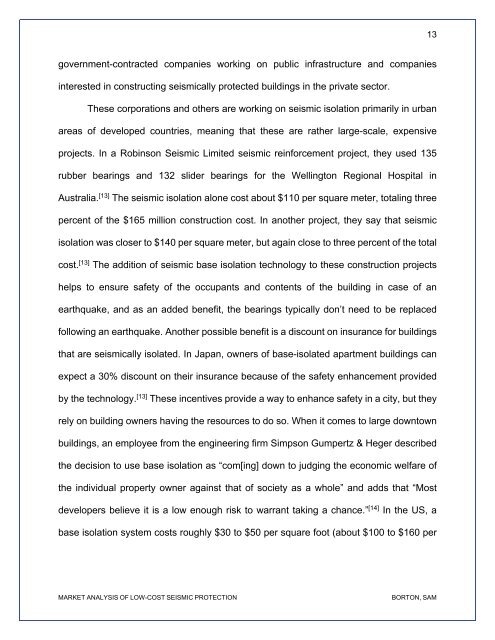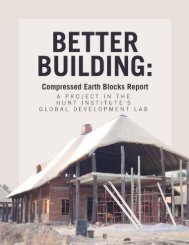Seeking Low-Cost Seismic Protection for Urban Masonry in an Unstable Terrain
Earthquakes pose a significant threat to housing in developing countries. The citizens of these countries often lack the financial means to sufficiently protect their homes against seismic actions. In accordance with the eleventh UN Sustainable Development Goal (SDG), steps need to be taken to protect these vulnerable populations from the looming possibility of a severe earthquake. Specifically, the geographic location of Peru designates it as an especially earthquake-prone country, and many of its citizens cannot afford seismic reinforcement for their homes. Middle-class, urban residents, such as those in Lima, Peru often reside in informally constructed confined masonry houses which, in the case of a severe earthquake, would likely suffer significant damage or even collapse. For this reason, the seismic protection market is increasingly narrowing its focus to low-cost solutions. This report summarizes the existing low-cost propositions and discusses to what extent they would provide a feasible option for the aforementioned target population in Peru. Finding that even these “low-cost” solutions are out of reach for most of the middle-class residents of Lima, this report makes an alternate proposition. Rocking isolation offers great potential as an innovative and economical seismic protection alternative, but it has yet to be implemented as low-cost housing reinforcement. This emerging system of seismic protection could fill a gap in the market as it may provide a sufficiently low-cost accessible manner of protecting confined masonry homes.
Earthquakes pose a significant threat to housing in developing countries. The citizens of these countries often lack the financial means to sufficiently protect their homes against seismic actions. In accordance with the eleventh UN Sustainable Development Goal (SDG), steps need to be taken to protect these vulnerable populations from the looming possibility of a severe earthquake. Specifically, the geographic location of Peru designates it as an especially earthquake-prone country, and many of its citizens cannot afford seismic reinforcement for their homes. Middle-class, urban residents, such as those in Lima, Peru often reside in informally constructed confined masonry houses which, in the case of a severe earthquake, would likely suffer significant damage or even collapse. For this reason, the seismic protection market is increasingly narrowing its focus to low-cost solutions.
This report summarizes the existing low-cost propositions and discusses to what extent they would provide a feasible option for the aforementioned target population in Peru. Finding that even these “low-cost” solutions are out of reach for most of the middle-class residents of Lima, this report makes an alternate proposition. Rocking isolation offers great potential as an innovative and economical seismic protection alternative, but it has yet to be implemented as low-cost housing reinforcement. This emerging system of seismic protection could fill a gap in the market as it may provide a sufficiently low-cost accessible manner of protecting confined masonry homes.
You also want an ePaper? Increase the reach of your titles
YUMPU automatically turns print PDFs into web optimized ePapers that Google loves.
13<br />
government-contracted comp<strong>an</strong>ies work<strong>in</strong>g on public <strong>in</strong>frastructure <strong>an</strong>d comp<strong>an</strong>ies<br />
<strong>in</strong>terested <strong>in</strong> construct<strong>in</strong>g seismically protected build<strong>in</strong>gs <strong>in</strong> the private sector.<br />
These corporations <strong>an</strong>d others are work<strong>in</strong>g on seismic isolation primarily <strong>in</strong> urb<strong>an</strong><br />
areas of developed countries, me<strong>an</strong><strong>in</strong>g that these are rather large-scale, expensive<br />
projects. In a Rob<strong>in</strong>son <strong>Seismic</strong> Limited seismic re<strong>in</strong><strong>for</strong>cement project, they used 135<br />
rubber bear<strong>in</strong>gs <strong>an</strong>d 132 slider bear<strong>in</strong>gs <strong>for</strong> the Well<strong>in</strong>gton Regional Hospital <strong>in</strong><br />
Australia. [13] The seismic isolation alone cost about $110 per square meter, total<strong>in</strong>g three<br />
percent of the $165 million construction cost. In <strong>an</strong>other project, they say that seismic<br />
isolation was closer to $140 per square meter, but aga<strong>in</strong> close to three percent of the total<br />
cost. [13] The addition of seismic base isolation technology to these construction projects<br />
helps to ensure safety of the occup<strong>an</strong>ts <strong>an</strong>d contents of the build<strong>in</strong>g <strong>in</strong> case of <strong>an</strong><br />
earthquake, <strong>an</strong>d as <strong>an</strong> added benefit, the bear<strong>in</strong>gs typically don’t need to be replaced<br />
follow<strong>in</strong>g <strong>an</strong> earthquake. Another possible benefit is a discount on <strong>in</strong>sur<strong>an</strong>ce <strong>for</strong> build<strong>in</strong>gs<br />
that are seismically isolated. In Jap<strong>an</strong>, owners of base-isolated apartment build<strong>in</strong>gs c<strong>an</strong><br />
expect a 30% discount on their <strong>in</strong>sur<strong>an</strong>ce because of the safety enh<strong>an</strong>cement provided<br />
by the technology. [13] These <strong>in</strong>centives provide a way to enh<strong>an</strong>ce safety <strong>in</strong> a city, but they<br />
rely on build<strong>in</strong>g owners hav<strong>in</strong>g the resources to do so. When it comes to large downtown<br />
build<strong>in</strong>gs, <strong>an</strong> employee from the eng<strong>in</strong>eer<strong>in</strong>g firm Simpson Gumpertz & Heger described<br />
the decision to use base isolation as “com[<strong>in</strong>g] down to judg<strong>in</strong>g the economic welfare of<br />
the <strong>in</strong>dividual property owner aga<strong>in</strong>st that of society as a whole” <strong>an</strong>d adds that “Most<br />
developers believe it is a low enough risk to warr<strong>an</strong>t tak<strong>in</strong>g a ch<strong>an</strong>ce.” [14] In the US, a<br />
base isolation system costs roughly $30 to $50 per square foot (about $100 to $160 per<br />
MARKET ANALYSIS OF LOW-COST SEISMIC PROTECTION<br />
BORTON, SAM













